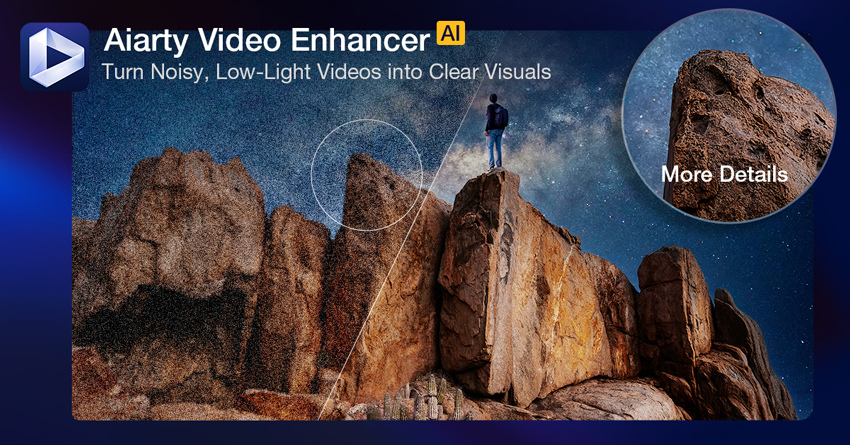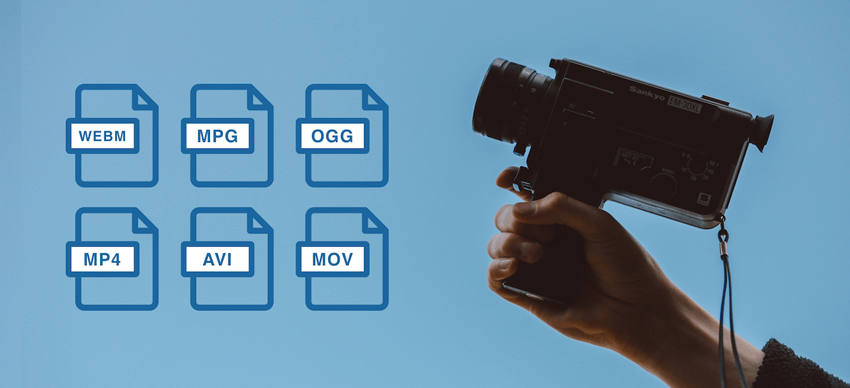Choosing the right video format can make or break your content. The format you use directly impacts video quality, file size, compatibility, and even SEO performance. From MP4 and MOV to WebM and AVI, each format has its strengths—and picking the wrong one can lead to playback issues, bloated files, or poor quality. This guide breaks down the best video formats in 2025, explains how they differ, and helps you choose the right one based on your goals. Ideal for content creators, marketers, editors, and anyone working with video, this guide ensures your videos are optimized for performance and playback on any platform.
If you want to take your videos to the next level, Aiarty Video Enhancer is a smart choice. Powered by advanced AI technology, Aiarty helps improve video clarity, reduce noise, and upscale resolution effortlessly — perfect for creators looking to boost their video quality without complicated software. Whether you're enhancing old footage or polishing new projects, Aiarty offers a user-friendly interface and fast processing to save you time.
- Batch upscale, denoise, sharpen, and restore videos with AI offline.
- Generate more video details for skin, hair, foliage, fabric, etc.
- Super denoiser built-in, optimized for low-light, grainy scenes.
- Turbo speed! Efficient AI model optimization for 95% GPU usage.
- Restore old footage, anime, AI videos, and recordings to 4K clarity.

What Is a Video Format?
A video format is a specific way of storing digital video data, and it determines how your video is compressed, played back, edited, and shared. At its core, a video format typically includes two main components: the container and the codec.
- The container is the file type you see, such as .mp4, .mov, or .mkv. It acts like a wrapper that holds all the video data, including audio, subtitles, and metadata.
- The codec (short for coder-decoder) is responsible for compressing and decompressing the video itself. Popular codecs include H.264, HEVC (H.265), VP9, and the newer AV1.
Together, the container and codec determine your video's quality, file size, and compatibility across devices or platforms. Understanding these elements is essential to choosing the best video format for your needs—whether you want crystal-clear playback, efficient streaming, or easy editing.

Container vs Codec vs File Extension
When working with video formats, it's important to distinguish between container, codec, and file extension—terms that are often used interchangeably but refer to different things:
- Container: This is the outer layer or wrapper of a video file. It organizes how the video, audio, subtitles, and metadata are stored together. Common containers include MP4, MOV, MKV, and AVI. Think of it as a box that holds all the components of your video project.
- Codec: The codec is what compresses and decompresses your video and audio data. For example, H.264, HEVC (H.265), VP9, and AV1 are codecs that reduce file size while maintaining quality. The codec used inside the container greatly affects playback compatibility and performance.
- File Extension: This is the suffix at the end of a video file name (like .mp4 or .mov). While it usually matches the container, it doesn't tell you everything about the internal codec, which is why two .mp4 files can behave very differently.
Understanding these distinctions helps you select formats that strike the right balance between quality, compatibility, and efficiency.
Why Video Format Matters
Choosing the right video format isn't just a technical decision—it directly affects how your content performs and who can view it. The format you choose impacts four key areas:
- Compatibility: Some formats won't play on certain devices or browsers. Choosing a widely supported format like MP4 ensures smooth playback across platforms.
- File Size: The format and codec determine how compressed your video is. Efficient formats like H.264 or AV1 can deliver high-quality video with smaller file sizes, which is ideal for streaming or uploading.
- Video Quality: The wrong format can lead to blurry visuals, artifacts, or loss of detail. Some formats are better suited for editing or preserving raw quality, while others prioritize efficient delivery.
- Workflow Efficiency: Using the right format saves time during editing, exporting, and uploading. It also helps avoid frustrating conversion errors or playback issues down the line.
In short, your choice of video format influences not only the viewer experience but also your production speed and content reach.

The Most Popular Video Format in 2025
MP4 (H.264/H.265)
MP4 is the most commonly used video format thanks to its versatility and widespread compatibility. It uses the H.264 codec by default, which offers excellent compression without sacrificing quality. The newer H.265 (HEVC) codec improves compression efficiency further, making it ideal for 4K or HDR videos. MP4 files work seamlessly on almost every device and platform—from smartphones and web browsers to video editors and social media. Its balance of quality, file size, and support makes it the safest and most recommended choice for most users.
WebM (VP8/VP9/AV1)
WebM is an open-source format developed by Google, designed mainly for web video streaming. It uses the VP8, VP9, or the newer AV1 codec, which offer better compression than H.264. WebM is supported by major browsers like Chrome and Firefox but less so by some older platforms and devices. Its efficiency in streaming and reducing bandwidth costs makes it a popular choice for websites and video platforms aiming for fast, high-quality playback.
MOV (Apple ProRes)
MOV is a format developed by Apple, commonly used in professional video editing workflows. Apple ProRes codecs inside MOV files provide very high quality and minimal compression loss, making it a favorite for video post-production and color grading. However, MOV files tend to be much larger and less compatible with non-Apple devices unless converted.
MKV (Matroska)
MKV is a highly flexible container format that supports multiple video and audio codecs, subtitles, and metadata in a single file. It's popular for high-quality video archiving and streaming, but its compatibility is more limited compared to MP4. MKV files are widely used for HD videos and Blu-ray rips, especially in community and enthusiast circles.
AVI (Audio Video Interleave)
AVI is one of the oldest video formats developed by Microsoft. It offers less efficient compression, resulting in larger file sizes with comparable quality. AVI files are compatible with many Windows applications but less optimized for streaming or modern devices. It's rarely recommended for new projects today.
WMV (Windows Media Video)
WMV is a Microsoft-developed format optimized for Windows environments. It offers decent compression but limited support outside Windows-based platforms. It's sometimes used for legacy content but has largely been replaced by more versatile formats.
FLV (Flash Video)
Once popular for online streaming, FLV is tied to Adobe Flash Player technology, which is now deprecated. FLV files are rarely used today and generally not recommended for new videos due to poor compatibility and security concerns.
Best Video Format Compared
Best Video Format by Use Case
The Best Video Format for Social Media
Social media platforms each have their preferred video formats to ensure smooth playback and optimal quality.

1. YouTube
MP4 with the H.264 codec is the top choice for YouTube uploads. It balances high quality with manageable file sizes and is fully compatible with YouTube's encoding systems. YouTube also supports VP9 and AV1 formats but uploading MP4 is still recommended for easiest compatibility.
2. Instagram
Instagram favors MP4 (H.264) for all IG video uploads, including Stories and Reels. This format ensures your videos play smoothly on mobile devices with minimal compression loss, maintaining visual quality.
3. Facebook
Facebook supports multiple formats but recommends MP4 with H.264 codec. It provides consistent playback across devices and good compression for fast uploads and streaming. Learn best format, size, specs for Facebook videos & ads >>
4. Twitter
Twitter prefers MP4 (H.264) for videos. The format helps keep file sizes small for quick sharing, while maintaining acceptable quality for mobile and desktop viewers.
5. TikTok
TikTok also recommends MP4 (H.264) for video uploads, especially for short-form content. This format ensures your videos maintain quality while keeping file size manageable for quick uploads and smooth playback on smartphones.
The Best Video Format for Storage and Archiving
For long-term storage, prioritize formats that maintain quality with little compression loss. MKV and MOV (especially with Apple ProRes or lossless codecs) are excellent choices. These containers support multiple audio tracks and subtitles, ideal for archiving master files or original footage.
The Best Video Format for Streaming Platforms
Streaming platforms need formats optimized for delivering quality video at low bandwidth. MP4 with H.265 (HEVC) is popular for 4K and HDR streams. WebM with VP9 or AV1 codecs is increasingly used for web streaming, offering efficient compression and fast loading times.
The Best Video Format for Video Editing
Professional editing workflows benefit from formats that preserve maximum quality and support easy editing. MOV with Apple ProRes or DNxHD formats are industry standards for this purpose. They produce large files but avoid quality loss, allowing more flexibility during post-production.
The Best Video Format for Web and SEO
For web video, formats must balance compatibility, speed, and quality. MP4 (H.264) remains the safest choice for broad device support. WebM with VP9 or AV1 codecs improves compression and load times, which can enhance SEO by reducing bounce rates and improving user experience.
How to Choose the Best Video Format
Selecting the best video format depends on your specific needs and priorities. Here are the key factors to consider when making your choice:
1. Compatibility
Ensure your video format works on the devices and platforms where your audience will watch it. MP4 (H.264) offers the broadest compatibility, but if your audience mainly uses modern browsers, formats like WebM or AV1 might be suitable.
2. Quality vs. File Size
Higher quality videos typically come with larger file sizes. If you need crisp visuals for professional editing or archiving, prioritize formats like MOV with ProRes codecs. For sharing online or streaming, formats with better compression like MP4 (H.265) or WebM balance quality and size efficiently.
3. Purpose and Use Case
Your video's purpose—whether it's for social media, web streaming, professional editing, or archiving—strongly influences the format choice. Match your format to the use case for optimal results.
4. Editing Requirements
If you plan to edit your video extensively, choose formats that maintain quality and support non-destructive editing, like MOV (ProRes) or DNxHD.
5. Bandwidth and Storage Constraints
For online streaming or sharing over limited internet connections, choose formats with efficient compression to reduce buffering and save bandwidth.
6. Platform or Service Guidelines
Many platforms have specific format recommendations or requirements. Check guidelines for YouTube, Instagram, Facebook, or your hosting service to avoid upload errors or poor playback.
Taking these factors into account will help you confidently select the video format that fits your goals and ensures the best viewing experience for your audience.
 FAQs
FAQs
Yes, there are many free and paid video converters available that let you change formats. Popular options include HandBrake, VLC, and VideoProc Converter AI. VideoProc Converter AI stands out for its user-friendly interface and powerful AI-enhanced conversion capabilities, supporting a wide range of formats while preserving high video quality and speeding up processing with GPU acceleration.
MP4 is the most versatile format and works well for most uses, but specialized cases like professional editing or archival storage may require formats like MOV or MKV.
Modern codecs like H.265 (HEVC) and AV1 provide better compression, resulting in smaller file sizes while maintaining good quality, typically inside MP4 or WebM containers.
MP4 (H.264) is universally accepted across all major social media platforms, making it the safest and most reliable option.